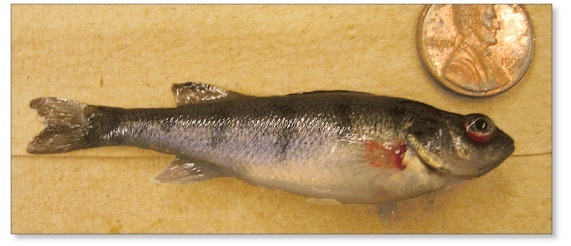Deadly fish virus still present in Wisconsin lake

This yellow perch is showing evidence of viral hemorrhagic septicemia virus — for example, hemorrhaging in the eye and bleeding in a pectoral fin.
Photo: Evi Emmenegger/USGS
In May 2007, hundreds of freshwater drum — also known as sheepshead — turned up dead in Lake Winnebago and nearby Little Lake Butte des Morts, both inland lakes near Oshkosh, Wisconsin. The fish were splotched with red and their eyes were swollen and bulging.
The Wisconsin Department of Natural Resources (DNR) launched a quick response and, working with the Wisconsin Veterinary Diagnostic Laboratory (WVDL), quickly learned that a deadly virus was responsible: viral hemorrhagic septicemia virus, or VHSv. First detected in the U.S. among freshwater fish in 2005 — including muskellunge, perch and walleye — VHSv had already caused mass fish die-offs in the Great Lakes and several regional waterways connected to them.

Tony Goldberg
The DNR subsequently encouraged anglers and boaters to adopt practices that have helped slow the spread of VHSv into other inland lakes in Wisconsin, but a new study led by Tony Goldberg, professor of epidemiology and pathobiological sciences at the University of Wisconsin–Madison School of Veterinary Medicine (SVM), shows the virus is still circulating in Lake Winnebago. It also shows that some fish actually survive VHSv infection but could be sources of future infections.
“It’s still possible to transmit the virus to fish in other lakes,” says WVDL Virology Section Head Kathy Toohey-Kurth, a member of the research team and a clinical professor at the SVM. Though large numbers of dead fish are no longer washing up on shore, “it shows the virus is still transmitting and people still have to be careful to follow all the guidelines from the DNR, like not carrying buckets of bait between waters,” she adds.
Drum are a food source for popular game fish like walleye and sauger. VHSv does not infect people, but 28 species of fish are vulnerable to the virus, which causes them to bleed to death. Some of these species, like bass and muskellunge, are iconic fishes that help support Wisconsin’s $2.3 billion-a-year sport fishing industry.

Kathy Toohey-Kurth
The findings of the current study, and the new diagnostic test upon which it relied, are aiding the DNR in efforts to monitor game fish in waterways throughout the state, in addition to better informing its stocking efforts.
The diagnostic test was developed by Toohey-Kurth — an expert in veterinary diagnostic testing — and Anna Wilson-Rothering, a WVDL scientist and lead author of the study. Wilson-Rothering is a former DNR employee who was involved in early VHSv surveillance efforts and earned her master’s degree from UW–Madison studying the virus. Efforts to develop the test started in 2009, shortly after Goldberg joined the faculty of UW–Madison and became involved in measures to prevent the spread of VHSv.
“I met with the DNR and we discussed some of the problems,” says Goldberg, who is also associate director for research at the Global Health Institute and John D. MacArthur Chair at UW–Madison. “It was very difficult to diagnose. It required you to kill the fish and take its internal organs to isolate the virus. It was also a lengthy process and very labor intensive.”
The new test requires just a small blood sample from the fish, which can be caught, sampled and released back to the water. The researchers take the blood back to the lab and look for evidence the fish were once infected with the virus: a specific antibody produced by the fish in response to infection. Like fingerprints on a doorknob at the scene of a crime, antibodies show the virus was once there.
The research team worked with the DNR to collect blood from nearly 600 drum in Lake Winnebago twice a year in 2011 and 2012 — both spring and fall — and used the test to look for VHSv antibodies. The team also collected fish to look for those that may still harbor active virus, finding it in just one: a large, older female. This provided “proof that the virus is still present in the lake,” Goldberg says. “Fish are still being exposed.”

The researchers believe that enough drum have been infected with and survived the virus, their antibodies providing protection from re-infection, that mass fish kills have probably not occurred. This phenomenon is referred to as “herd immunity” and is similar to what happens when a large group of people is vaccinated against a disease like measles. If enough individuals are protected, less of the virus circulates and infects the unprotected.
But once levels of protected individuals fall, either from deaths from other causes, or as large numbers of new, unprotected fish are born, another wave of VHSv-induced deaths could occur. Researchers will continue to monitor for the virus and the study, they say, underscores the importance of collaborative scientific efforts with the DNR and the role these efforts play in addressing the needs of the state.
“This test will continue to be useful to monitor VHSv transmission,”says Toohey-Kurth, “and with further refinements we will be able to better assist our state partners with management of the disease.”
The study, published in the Journal of Clinical Microbiology, was supported by the University of Wisconsin Sea Grant Institute with funding from the National Oceanic and Atmospheric Administration. Co-authors of the study include now-retired fish health specialist Sue Marcquenski and other scientists from the DNR, researchers from the U.S. Geological Survey (USGS), and scientists from the University of Wisconsin-Stevens Point and the University of Iowa.
